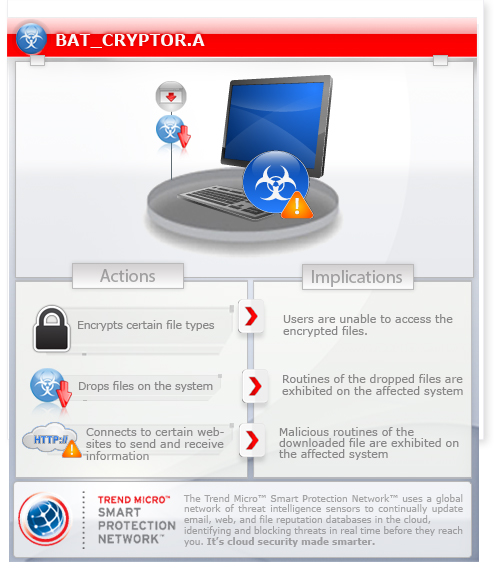BAT_CRYPTOR.A
Trojan-Ransom.BAT.Agent.aa(Kaspersky)
Windows 2000, Windows Server 2003, Windows XP (32-bit, 64-bit), Windows Vista (32-bit, 64-bit), Windows 7 (32-bit, 64-bit)


Threat Type: Trojan
Destructiveness: No
Encrypted: No
In the wild: Yes
OVERVIEW
Downloaded from the Internet, Dropped by other malware
This ransomware uses the GNU Privacy Guard application, a legitimate app in order to encrypt files.
To get a one-glance comprehensive view of the behavior of this Trojan, refer to the Threat Diagram shown below.

This Trojan may arrive bundled with malware packages as a malware component. It arrives on a system as a file dropped by other malware or as a file downloaded unknowingly by users when visiting malicious sites.
It deletes itself after execution.
TECHNICAL DETAILS
Varies
BAT
No
17 Jul 2014
Encrypts files, Drops files
Arrival Details
This Trojan may arrive bundled with malware packages as a malware component.
It arrives on a system as a file dropped by other malware or as a file downloaded unknowingly by users when visiting malicious sites.
Installation
This Trojan creates the following folders:
- %User Temp%\KEYPRIVATE
(Note: %User Temp% is the current user's Temp folder, which is usually C:\Documents and Settings\{user name}\Local Settings\Temp on Windows 2000, XP, and Server 2003, or C:\Users\{user name}\AppData\Local\Temp on Windows Vista, 7, and 8.)
Dropping Routine
This Trojan drops the following files:
- C:\PAYCRYPT_GMAIL_COM.txt
- D:\PAYCRYPT_GMAIL_COM.txt
- %Application Data%\Desktop\PAYCRYPT_GMAIL_COM.txt
- %Desktop%\PAYCRYPT_GMAIL_COM.txt
- %User Temp%\PAYCRYPT_GMAIL_COM.txt
- %User Temp%\pycrp.bin -once this already existed it will not continue its routine
(Note: %Application Data% is the current user's Application Data folder, which is usually C:\Documents and Settings\{user name}\Application Data on Windows 2000, XP, and Server 2003, or C:\Users\{user name}\AppData\Roaming on Windows Vista, 7, and 8.. %Desktop% is the current user's desktop, which is usually C:\Documents and Settings\{User Name}\Desktop on Windows 2000, XP, and Server 2003, or C:\Users\{user name}\Desktop on Windows Vista, 7, and 8.. %User Temp% is the current user's Temp folder, which is usually C:\Documents and Settings\{user name}\Local Settings\Temp on Windows 2000, XP, and Server 2003, or C:\Users\{user name}\AppData\Local\Temp on Windows Vista, 7, and 8.)
Other Details
This Trojan encrypts files with the following extensions:
- *.xls
- *.xlsx
- *.doc
- *.docx
- *.jpg
- *.cd
- *.jpeg
- *.1cd
- *.rar
- *.mdb
- *.zip
It renames encrypted files using the following names:
- {file name and extension}.paycrypt@gmail_com
It deletes itself after execution.
NOTES:
It encrypts file from drives B:\ to Z:\.
The dropped file PAYCRYPT_GMAIL_COM.txt contains the following:
- BLOCK DATE: {Date and time accomplished the encryption}
It deletes the following directory %APPDATA%\gnupg.
It will delete components used in encryption.
When the required components exist, it will dropped the following files:
- %User Temp%\DECODE.zip
- C:\DECODE.zip
- D:\DECODE.zip
- %User Profile%\Desktop\DECODE.zip
- %Application Data%\Desktop\DECODE.zip
- %User Temp%\KEY.PRIVATE
- %User Temp%\KEYPRIVATE\KEY.PRIVATE
- %Application Data%\KEY.PRIVATE
- C:\KEY.PRIVATE
- D:\KEY.PRIVATE
- %Desktop%\KEY.PRIVATE
- %Application Data%\Desktop\KEY.PRIVATE
SOLUTION
9.700
10.938.05
22 Jul 2014
10.939.00
23 Jul 2014
Step 1
Before doing any scans, Windows 7, Windows 8, Windows 8.1, and Windows 10 users must disable System Restore to allow full scanning of their computers.
Step 2
Note that not all files, folders, and registry keys and entries are installed on your computer during this malware's/spyware's/grayware's execution. This may be due to incomplete installation or other operating system conditions. If you do not find the same files/folders/registry information, please proceed to the next step.
Step 3
Search and delete this file
- C:\PAYCRYPT_GMAIL_COM.txt
- D:\PAYCRYPT_GMAIL_COM.txt
- %Application Data%\Desktop\PAYCRYPT_GMAIL_COM.txt
- %Desktop%\PAYCRYPT_GMAIL_COM.txt
- %User Temp%\PAYCRYPT_GMAIL_COM.txt
- %User Temp%\pycrp.bin
- %User Temp%\DECODE.zip
- C:\DECODE.zip
- D:\DECODE.zip
- %User Profile%\Desktop\DECODE.zip
- %Application Data%\Desktop\DECODE.zip
- %User Temp%\KEY.PRIVATE
- %Application Data%\KEY.PRIVATE
- C:\KEY.PRIVATE
- D:\KEY.PRIVATE
- %Desktop%\KEY.PRIVATE
- %Application Data%\Desktop\KEY.PRIVATE
Step 4
Search and delete these folders
- %User Temp%\KEYPRIVATE
Step 5
Scan your computer with your Trend Micro product to delete files detected as BAT_CRYPTOR.A. If the detected files have already been cleaned, deleted, or quarantined by your Trend Micro product, no further step is required. You may opt to simply delete the quarantined files. Please check the following Trend Micro Support pages for more information:
Did this description help? Tell us how we did.

